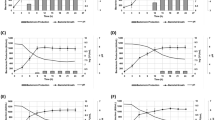Abstract
Bacterial vaginosis can be treated by restoring the normal vaginal flora using lactobacilli.Lactobacillus crispatus KLB46 that was isolated from the human vagina has a strong antimicrobial activity and was grown in a batch and in a continuous fermentor. During batch cultivation, the maximum specific growth rate ofL. crispatus KLB 46 was 0.63 h−1 and the highest viable cell count (1.9×109 CFU/mL) was obtained at pH 5.5.L. crispatus KLB 46 did not grow well at either pH 3.5 or 7.5. During continuous cultivation, the highest viable cell count (1.53×109 CFU/mL) was obtained at a dilution rate of 0.32 h−1. However, the maximum productivity of viable cells was obtained at a dilution rate of 0.52 h−1, and was 7.33×1011 CFU L−1 h−1, that is approximately 5 times higher than that obtained from batch culture.
Similar content being viewed by others
References
Hughes, V.L. and S. L. Hillier (1990) Microbiologic characteristics ofLactobacillus products used for colonization of the vagina.Obsfet. Gynecol. 75: 244–248.
Kang, M. H. and J. W. Lee (1998) Continuous cultivation of human intestinal micro flora at high cell concentration via controlled culture recycle.Biotechnol. Lett. 20: 295–299.
Eschenbach, D. A., P. R. Davick, B. L. Williams, S. J. Klebanoff, K. Young-Smith, C. M. Critchlow, and K. K. Holmes (1989) Prevalence of hydrogen peroxide-prodicingLactobacillus species in normal women and women with bacterial vaginosis.J. Clin. Microbiol. 27: 251–256.
Pavlova, S. I., A. O. Kilic, S. M. Mou, and L. Tao (1997) Phage infection in vaginal lactobacilli: Anin vitro study.Infect. Dis. Obstet. Gynecol. 5: 36–44.
Blackwell, A. L., A. R. Fox, I. Phillips, and D. Barlow (1983) Anaerobic vaginosis (non-specific vaginitis): climcal, microbiological, and therapeutic findings.The Lance. 322: 1379–1382.
Bruce, A. W. and G. Reid (1988) Intravaginal instillation of Lactobacilli for prevention of recurrent urinary track infections.Can. J. Microbiol. 34: 339–343.
Maggi, L., P. Brigidi, D. Matteuzzi, and U. Conte (1994) Pharmaceutical formulations for the vaginal administration of viable microorganisms.Eur. J. Pharm. Biopharm. 40: 176–178.
Parent, D., M. Bossens, D. Bayot, C. Kirkpatrick, F. Graf, F. E. Wilkinson, and R. R. Kaiser (1996) Therapy of bacterial vaginosis using exogenously-applied Lactobacilli acidophili and a low dose of Estriol A placebo-controlled multicentric clinical trial.Arznem.-Forsch./Drug Res. 46: 68–73.
Chang, C. E. (2000)Isolation and Characterization of Lactebacillus spp. from Human Vagina for the Ecological Treatment of Bacterial Vaginosis. M. S. Thesis, Inha University, Incheon, Korea.
Kilic, A. O., S. I. Pavlova, W. G. Ma, and L. Tao (1996) Analysis oflactobacillus phages and bacteriocins in American dairy products and characterization of a phage isolated from yogurt.Appl. Environ. Microbiol. 62: 2111–2116.
De Man, J. C., M. Rogosa, and M. E. Sharpe (1960) A medium for the cultivation of Lactobacilli.J. Appl. Bacl. 23: 130–135.
Verellen, T. L. J., G. Bruggeman, C. A. Van Reenen, L. M. T. Dicks, and E. J. Vandamme (1998) Fermentation optimization of Plantaricin 423, a bacteriocin produced byLactobacillus plantarunt 423.J. Ferment. Bioeng. 86: 174–179.
Ragout, A., F. Sineriz, H. Diekmann, and G. E. Valdez (1994) Effect of environmental pH on the fermentation balance ofLactobacillus reuteri.J. Appl. Bacteriel. 77: 388–391.
Berry, A. R., C. M. M. Franco, W. Zhang, and A. P. J. Middelberg (1999) Growth and lactic acid production in bath culture ofLactobacillus rhamuosus in a defined medium.Biotechnol. Lett. 21: 163–167.
Senthuran, A., V. Senturan, B. Mattiasson, and R. Kaul (1997) Lactic acid fermentation in a recycle batch reactor using immobolozedLactobacillus casei.Biotechnol Bioer 55: 841–853.
Kandler, O. and N. Weiss (1986) Regular, non-sporing gram-positive rods. pp. 1208–1234. In: P. H. A. Sneath, N. Mair, M. E. Sharpe, and J. G. Holt (eds).Bergev’s Manual of Systematic Bacteriology. Vol. 2. William and Wilkins. Baltimore, MD, USA.
de Vries, W., W. M. Kapteijn, E. G. van der Beek, and A. H. Stouthamer (1970) Molar growth yields and fermentation balances ofLactobacillus casel L3 in batch cultures and in continuous cultures.J. Gen. Microbiol. 63: 333–345.
Dirar, H. and E. B. Collins (1972) End-products, fermentation balances and molar growth yields of homofermentative lactobacilli.J. Gen. Microbiol. 73: 233–238.
Author information
Authors and Affiliations
Corresponding author
Rights and permissions
About this article
Cite this article
Chang, C.E., Kim, SC., So, JS. et al. Cultivation ofLactobacillus crispatus KLB46 isolated from human vagina. Biotechnol. Bioprocess Eng. 6, 128–132 (2001). https://doi.org/10.1007/BF02931958
Received:
Accepted:
Issue Date:
DOI: https://doi.org/10.1007/BF02931958



